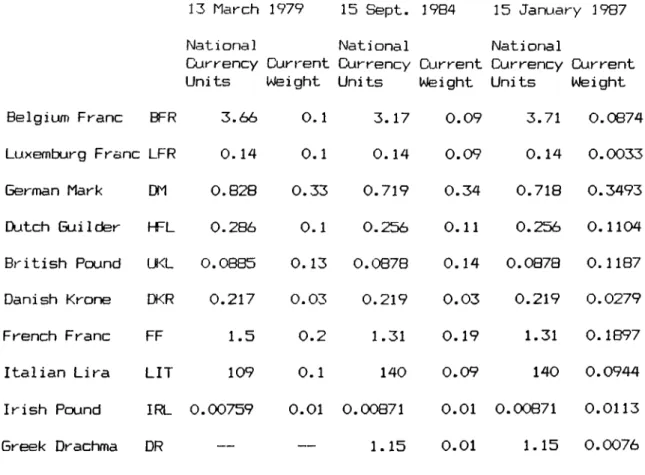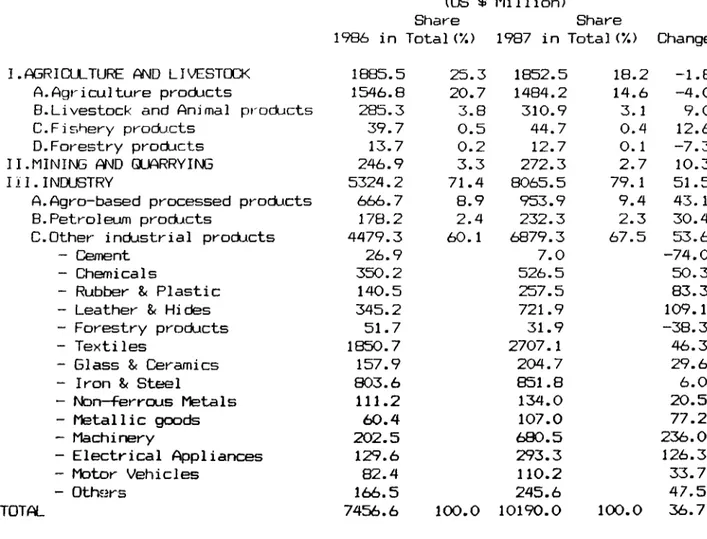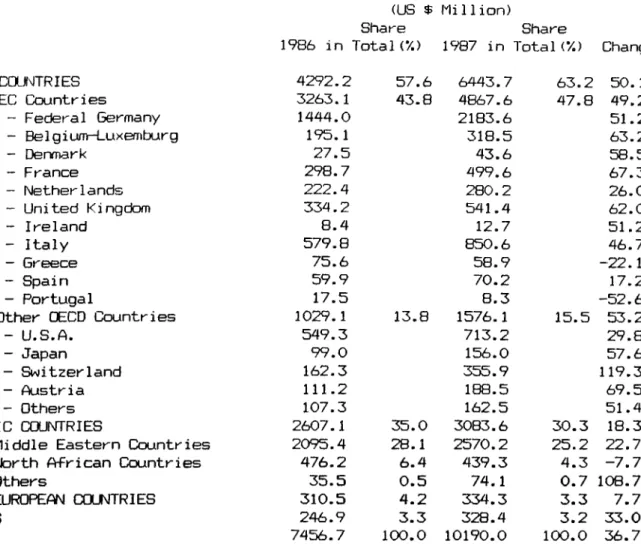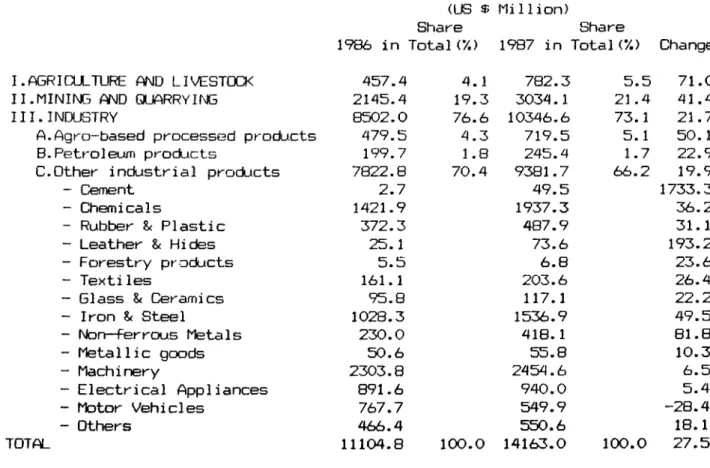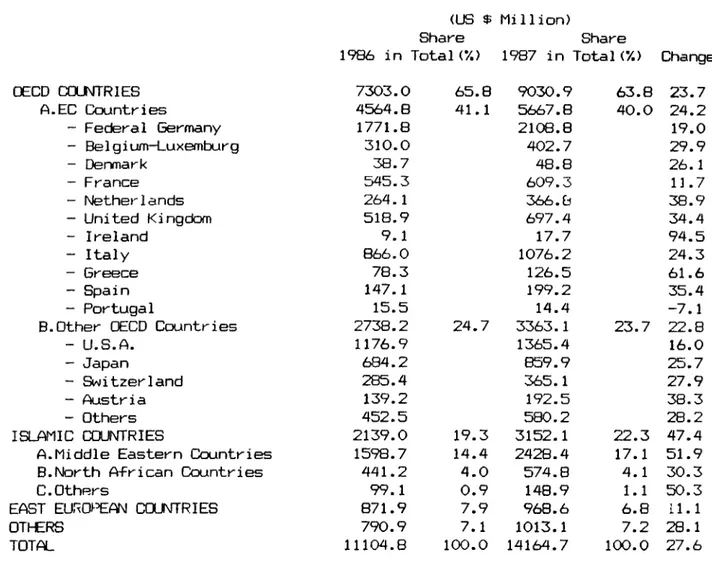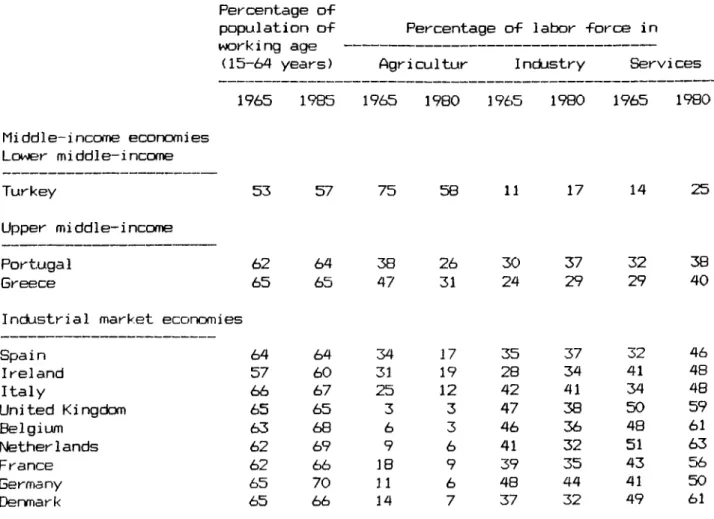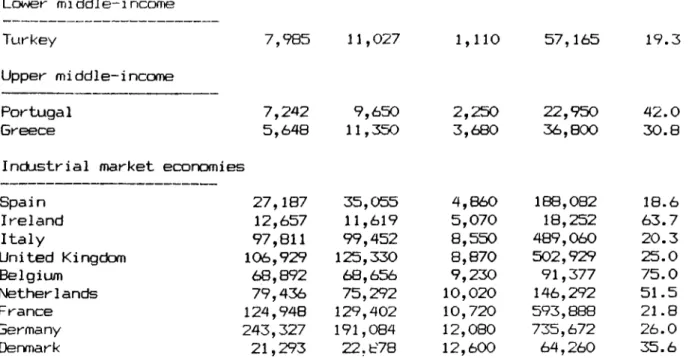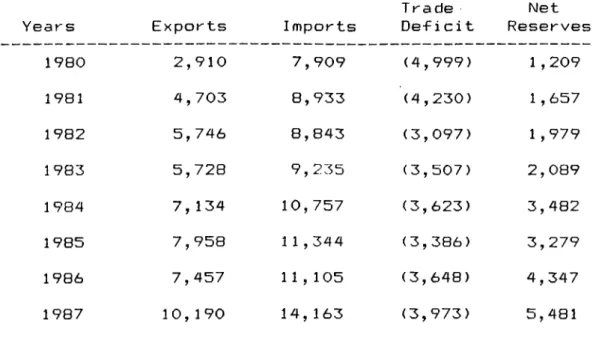IMPLICATIONS OF
THE EUROPEAN MONETARY SYSTEM FOR TURKEY
A THESIS
SUBMITTED TO THE DEPARTMENT OF MANAGEMENT AND THE GRADUATE SCHOOL OF BUSINESS ADMINISTRATION
OF BILKENT UNIVERSITY
IN PARTIAL FULFILLMENT OF THE REQUIREMENTS FOR THE DEGREE OF MASTER OF BUSINESS ADMINISTRATION
By
AKIN TAMER OCTOBER, 1989
Vve» nıo.s 'Т±Ч>І
I certify that I have read this thesis and in my opinion it is fully adequate, in scope and in quality, as a thesis for the degree of Master of Business Administration.
I certify that I have read this thesis and in my opinion it is fully adequate, in scope and in quality, as a thesis for the degree of Master of Business Administration.
Assist. Prof. Kur^at Aydogan
I certify that I have read this thesis and in my opinion it is fully adequate, in scope and in quality, as a thesis for the degree of Master of Business Administration.
r
Assist. Prof. Erol Çakmak
Approved for the Graduate School of Business Administration
Prof. Dr. Subidey Togan
I would like to thank to my supervisor Assist. Prof. Gökhan Capoglu for his support, encouragement and guidance for the preparation of this thesis.
I would also like to thank to Assist. Prof. Kursat AydoQan and Assist. Prof. Erol Çakmak for their comments and suggestions.
A C K N O W L E D G E M E N T S
ABSTRACT
IMPLICATIONS OF THE
EUROPEAN MONETARY SYSTEM FOR TURKEY
AKIN TAMER
M.B.A. in MANAGEMENT
Supervisor: Ass i s t . Pro-f. GÖKHAN CAPOGLU October 1989, 62 Pages
The objective of this study is to analyze the economic differences between Turkey and the members of European Monetary System, and discuss the membership with its costs and benefits and structural constraints.
According to the comparisons in terms of inflation level, GNP, competitiveness, exchange rate regime, structure of labor force, there are gaps between Turkey and member countries of the EMS.
When those economic differences, structural constraints and their impacts on the Turkish economy are considered, Turkey should not consider membership to the
EMS-Key words: monetary union, benefits and costs of entering EMS, economic differences between Turkey and EMS members
ÖZET
AVRUPA PARA SİSTEMİNİN TÜRKİYE ICIN ÖNEMİ
AKIN TAMER
Yüksek Lisans Tezi, İsletme Enstitüsü Tez Yöneticisi: GÖKHAN CAPDGLU
Ekim 1989, 62 Say-Fa
Bu çalışmanın amacı, Türkiye ile Avrupa Para Sistemi üyeleri arasındaki ekonomik f a r k 1ı1ık1arı incelemek ve Türkiye’nin olası üyeliğinin yararları ve faydalarını ve yapısal kıs11 1 ama 1 arını tar11şmak11r .
Enflasyon düzeyi, GSMH, rekabet gücü, döviz kuru rejimi ve işgücünün yapısı karşılaştırı1dıgında Türkiye'nin ve APS üye ülkelerinin ekonomileri arasında bir uçurum olduğu görülebilir.
Ekonomik f a r k 1111k 1 a r , yapısal sınırlamalar ve bunların Türk ekonomisi üzerindeki etkileri gözönüne alındığında, Türkiye, Avrupa Para Sistemine girebilmeyi düşünmeme1 i di r .
A n a h t a r k e l i m e l e r ; p a r asal birlik, A P S ’ ne g i r m e n i n f a y d a l a r ı ve z a r a r l a r ı , T ü r k i y e ve A P S ü y e le r i a r a s ı n d a k i e k o n o m i k f a r k l ı l ı k l a r
T A B L E OF C O N T E N T S Page ACKNOWLEDGEMENT İ Ü ABSTRACT iv ÖZET V TABLE OF CONTENTS vi
LIST OF TABLES viii
1. INTRODUCTION 1
1.1. INTRODUCTION TO THE PROBLEM 1
1.2. IMPORTANCE OF THE STUDY 1
1.3. OUTLINE OF THE THESIS 2
2. THEORY OF MONETARY UNIONS AND COMMON CURRENCY AREAS 3
2.1. INTRODUCTION 3
2.2. CONCEPT OF MONETARY UNION 4
2.3. BENEFITS AND COSTS OF ENTERING A MONETARY UNION 9 3. OPERATIONS AND COMPONENTS OF EMS 14
3.1. THE PURPOSE OF THE EMS 14
3.2. COMPONENTS OF THE EMS AND HOW THE SYSTEM WORKS 15 3 . 2 . 1 . The ECU
3 .2.2 The Exchange Rate and Intervention Mechani sm
3 .2.3. The Credit Mechanism
4. IMPLICATION OF THE EMS FOR NEW MEMBER STATES 4.1. POSSIBLE ADVANTAGES OF JOINING THE EMS 4.2. THE STRUCTURAL FACTORS
15 17 IS 19 1-9 21 V I
4.3. POSSIBLE CANDIDATES 23
5. IMPLICATIONS OF EMS FOR TURKEY 27
5.1. ECONOMIC ENVIRONMENT IN TURKEY 27 5.2. ECONOMIC DIFFERENCES BETWEEN EMS COUNTRIES AND
TURKEY 35
5.2.1. Economic Indicators 35
5.2.2. Exchange Rate Policy 30
5.2.3. Competitiveness 47
5.2.4. Convertibility 49
5.3. COSTS AND BENEFITS OF JOINING EMS FOR TURKEY 53 5.4. STRUCTURAL CONSTRAINTS FOR TURKEY TO JOIN EMS 56 6. CONCLUSION
REFERENCES
58 62
1. INTRODUCTION
1.1. INTRODUCTION TO THE PROBLEN
In 1992, the European Community will become what it set out to be “a common market*'. All the physical, fiscal and technical barriers will be removed. Although there are some potential problems, it seems that sooner or later Europe will succeed in forming an economic and monetary union. In the future the currency unification may come true. The first step for such an integration has been taken by the establishment of the Europec*n Monetary System (EMS) in 1979. Of course the EMS is far from being a common currency area but it is the first stage in this integration process. The purpose of this thesis is to analyze the possible position of Turkey in the EMS. Possible membership in the EMS is discussed with its benefits and costs, structural constraints and is concluded with recommendations to improve the present economic environment.
1.2. IMPORTANCE OF THE STUDY
Turkey applied to the European Economic Community (EEC) for the full membership in 1987. Such an application will be examined in terms of political and economic perspectives. A possible membership of Turkey to the EEC
İMİ 11 bring the question of membership to the EMS in the future. Since the membership of EMS is an economic issue, Turkey has to examine its economy with respect to the EMS"s imp1ications. Hence, this brings the importance of an economic analysis of possible r e 1 ationships between Turkey and the EMS.
1.3. OUTLINE OF THE THESIS
Second chapter reviews the theory of monetary unions with the requirements of forming monetary unions, benefits and costs of joining such a union. Third chapter summarizes the purpose, operations and components of the European Monetary System. The implications of the EMS for new member states with possible advantages and structural factors are discussed in chapter 4. In the fifth chapter, the implication of the EMS for Turkey, for example; the economic environment, costs and benefits for joining the EMS from Turkey's perspective are analyzed together with structural constraints. The last chapter covers the conclusions and recommendations.
2. THEORY OF MONETARY UNIONS
2.1. INTRODUCTION
A monetary union represents a group o-F countries that fix their exchange rates vis-a-vis each other. In such a union active use of domestic monetary policies are left to the central organization (ie. central bank) in order to coordinate the monetary actions of the union members. The extreme case of a monetary union would be a common currency area, in which states or countries arrange to utilize a common currency. The EMS is far from being a common currency area but it is claimed to be certainly an experiment in monetary union.^
Economic and monetary union is recognized as the long term goal of integration in the European Community. In other words, the EMS in its present form is a step on the way to economic and monetary union. According to the authorities, it is difficult to imagine the ECU in the role of common single currency that would be created by the achievement of economic and monetary union, without solving
^Francisco L. Rivera-Batiz and Luis Rivera-Batiz, I nternat i onal Finance__Open-Economy Macroeconom i c s , (New York, 1985), p.543.
^Commission of the European Communities, The__ECU (Luxemburg, 1987), pp.39-40,
significant institutional and monetary obstacles. Any future European currency cannot be based on the basket of Member States' currencies, but any other currency will have to be issued and managed by an European monetary institution, i.e. a central bank. But, these constraints do not diminish the contribution which the ECU can make to the integration process as:
<a) a symbolic European currency; (b) an international currency for Community operators; (c) an expression of the Community in the international monetary system; <d) a catalyst of monetary policy coordination within the Community.^
In the next section, the incentives behind forming a monetary union and requirements of such a union is o u t 1i ned.
2.2. CONCEPT OF MONETARY UNION
The European Community, that was established in 1957 with the ROME Agreement between six west European countries and then increase the number of members to twelve, most of all is a custom union. Custom union is a way of integration or an economic union in which custom tariffs are eliminated
^Commission of the European Communities, The__ECU (Luxemburg, 1907), pp.39-40.
between members and a common tariff system is applied to the third countries.
Since the tariffs are the most important barrier for the foreign trade, the internal trade within the community has increased as a result of eliminating those tariffs between members countries. Consequently, since 1957, the internal trade has increased seven times where as the trade with third countries has increased three times.
The elimination of tariffs provide the required precondition for development of trade between members. But it does not guarantee the future of this trade. For foreign traders the fluctuations in exchange rates and convertibility are the two important factors. For continuity of the trade, the fluctuations in exchange rates should be minimum and there should be full convertibility between currencies of the partners. This can be considered only when the countries establish a monetary union. By establishing a monetary union, the negative effects of fluctuations in exchange rates on trade will be eliminated.
Establishment of a monetary union between countries is a very difficult process because in such a union a member looses its independence on its own monetary policy. In this case, a monetary union can be established only when all the countries, which contemplate membership of such a union.
decide on a common policy. However, establishment of a monetary union still is a difficult and long term process. It is a long term process because of the differences in economic, political environment and policies applied between the member countries.
Monetary union brings some requirements among participant countries. Unity of exchange rates should be established between member countries. All the limitations that have been formed for the capital movements should be removed. The convertibi1ity between member countries should be realized and a guarantee to preserve this convertibility should be provided. Also the bank costs for the exchange of national currencies should be removed.
Establishing a unity of exchange rate is the first requirement for the formation of monetary union. Within the union, the national currencies settled to each other with constant parities within a fluctuation margin which is gradually narrowing and disappearing completely at the end.
The fluctuation margin shows in percentage the deviation of exchange rates from the announced parities- In this step, the members choose any currency as a measurement unit (standard or numeraire) in determining parities. In this case, the member countries try to fix the exchange rates of their currencies against this standard.
Ab a second step, a common reserve fund should be formed. The countries that practice surplus in their balance of payments, transfer some part of their reserves to that fund and the countries that practice deficit, protect their parities \^ith the credits from this fund. In order to form such a fund, full convertibi1ity between currencies of member countries should exist.
In forming such a fund, there will be the danger of financing the cronic balance of paynient deficits of some members by the other members- For this reason, in order to prevent chronic balance of payments deficits and surpluses with in the union, the coordination and adaptation of economic policies, especially monetary policies, should be created. This requires the centra 1ization of the policies and this can be done by forming a joint central bank- The members shall transfer their exchange reserves to the formed bank.
The Central Bank, intervenes the exchange market in order to fix the exchange rates between member countries and provides the free fluctuation of union currency against other currencies. The decisions about monetary policies are taken by this Central Bank and National Central Banks of the member countries function as the branches of this joint Central Bank. Also there should be harmony in fiscal policies within the union.
The member countries apply a fix exchange rate system between their national currencies by eliminating the fluctuation margin, on the other hand they apply a flexible system against non-member countries' currencies. In a monetary union there is no dominant country or currency. In addition, the currency unit of a monetary union can't be based on a basket of member countries' currencies.
If the unity of exchange rate is realized with the establishment of monetary union, the fixity in both spot and forward exchange rates is provided. (In spot markets currencies are bought and sold for immediate delivery and payment; in forward markets, contracts are provided for the delivery of currencies at some future date.^) Full convertibility provide the unity in spot and forward exchange rates. The inflation rate and interest rate differences constitute the differences in spot and forward exchange rates. As a result, within the union, capital flows freely according to the interest rates, so the integration of capital markets is provided.^
^Francisco L. Rivera-Batiz and Luis Rivera-Batiz, I nter nat iona 1 Finance__S< Open-Economy__Macroeconomics (New York, 1985), pp.46-47.
^Ri dvan K a r 1u k , Avrupa__Para__ Sistemi ni n__Kurulusu. İşleyişi ve__Sistem Karsisinda__Türkiye' nin__Dur umu j___ Genel Değerlendi rme (Ankara, May 1984), p.306.
The last step for a monetary union is the creation of a common currency unit. But this requires internal factor mobility and a high degree of wage/price interdependence with other regions.^
2.3. BENEFITS AND COSTS OF ENTERING A MONETARY UNION
Money has to serve as a universal measure of value, a universally accepted medium of exchange, and a store of value. Money in its role of medium of exchange is less useful if there are many currencies; although the costs of currency conversion are always present, they loom exceptionally large under inconvertibility or flexible exchange rates. So a common currency as a medium of exchange eliminates the costs of money conversion and uncertainity of flactuations. A currency of a large area would also be a good store of value. Ignoring inflation, such a currency can command a wide selection of commodities that are free from price changes due to exchange rate changes. Therefore, a common currency results in an efficient allocation of resources, more stability and
integration of the economy 7
^ R i d v a n K a r luk, B __ _______ S i s t e m i n i n K u r u l u s u , iş l e y i ş i v e __ S i s t e m K a r s i s i n d a __ Turk iye'ni n__ Durumu;___Genel D e ğ e r 1 endi rme (Ankara, May 1984), p.6.
^ Y o s h i h i d e Ishiyama, "The T h e o r y of O p t i m u m C u r r e n c y Areas: A S u r v e y " , I n t e r n a t i o n a l M o n e t a r y F u n d S t a f f P a p e r s , 22 (1975), p p . 344- 3 8 3 .
Ab long as exchange rates -fluctuate, the short-term speculative capital movements can occur. But when -Financial integration is realized within the union, the autonomy of monetary policy dwindles. Monetary disturbances inside the union as a source of exchange rate problems and speculative capital movements will gradually be removed. On the other hand, direct short-term monetary policy (interest rate policy and money supply changes) and the announcement effects of monetary changes in the sense of real adjustment can easily prevent specu1 a t i o n .^
With the participât ion to a monetary union, there will o
be a saving on exchange reserves. The reserves of participating countries are gathered in a common reserve •fund. By this way every member needs less reserves than they have by their own. In case of balance of payment deficits, the common reserve is used to meet this deficit. As a result, it is possible to finance more amount of deficits than the amount that the countries have to meet each by itself.
®Fair, D.E. and Boissieu, C.de, International_Monetary and Financial Integration - The European Dimension, (K 1uwer Academic Publishers, 1988), pp.299-302.
'^Yoshihide Ishiyama, "The T h e o r y o f O p t i m u m C u r r e n c y Areas: A S u rvey", I n t e r n a t i o n a l M o n e t a r y F u n d S t a f f P a p e r s , 22 (1975), p.363.
When we consider an individual nation, common currency or a -fixed exchange rate within a monetary union involves various economic losses.
First o-F all, the main implication o-f a common currency is the loss of autonomy in monetary policy. Especially for countries having small economies, this loss of national control over the exchange rate may be feared and rt3garded as dangerous by the national governments, for which differences in national wage, price, and productivity trends may persist. There is a danger that the country which has a chronic surplus will aggravate domestic inflation and the country with the deficit problem will suffer from further depression and unemployment, depending on the nature of the coordinated overall monetary policy of the u n i o n - I t can be explained by a demand shift from country B to country A- Because of the mobility of factors, this shift causes unemployment in B and inflationary pressure in A, and a surplus in A"s and deficit in B"s balance of payments. Supposing that the national governments apply a full employment policy, to correct the unemployment in B the monetary authorities increase the money supply. The monetary expansion, however, aggravates inflationary pressure in country A.
^ ^ V o s h i h i d e Ishiyama, "The T h e o r y of O p t i m u m C u r r e n c y Areas: A S u r vey", Inter nat i ona 1_M o n e tary F u n d S t a f f P a p e r s , 22 (1975), p p . 3 4 4 -383.
The applied policy by the monetary authority may not be beneficial for a particular region or nation- If one country tries monetary expansion, a downward pressure on the interest rate in that country would cause a capital outflow and a deterioration in the balance of payments, which would absorb domestic money. This process continues until the accumulated deficit restores the stock of domestic money to its original level. Thus, all real variables would remain unchanged. 11
A common currency area may imply "the worsening of the unemployment-inflation r e l a t i o n s h i p " F o r example the country having inflation rate lower than the other members and trade surplus within the union would probably play a dominant role and would force others to adjust. In this case, although the average rate of inflation was decreased with in the area, there will be a rise in unemployment in the union as a whole. The basic reason for this is the negative relationship between unemployment and inflation involved in the Phillips Curves in the short-run.
^^Voshihide Ishiyama, "The Theory of Optimum Currency Areas: A S urvey", Internatio n a 1 Monetary Fund Staff Papers, 22 (1975), pp.365.
Yoshi hi de Ishiyama, "The T h e o r y of O p t i m u m C u r r e n c y Areas: A Su r v e y " , In t e r n a t i o naI M o n e tary F u n d S t a f f P a pe r s, 22 (1975), p p . 344-383.
("The Phillips curve suggests a tradeo-F-f between inflation and unemployment; Jess unemployment can always be obtained by incurring more inflation - or inflation can be f'educed by allowing more unemployment."^^) Hence, there will be a worsening in the une m p 1oyment~inf1 ation relationship due to currency
unification-Also we should consider the national fiscal policies. In a currency union, national fiscal policies can not completely be free. Currency union imposes coordination of goals and policies - including fiscal policy - on the participating countries so that the union can maintain its joint external payments equilibrium. The elimination o-f countries" control over fiscal policies as well as in monetary policies, may effect the economic structure of the countries having internal economic difficulties.
^^Dornbusch, R. (1984), p . 15.
and Fischer, S., Macroeconomi c s ,
3. OPERATIONS AND COMPONENTS OF EMS
3.1. THE PURPOSE OF THE EMS
The EMS commenced its operations on March 13, 1979 and the nine EC countries became members of the system after their central banks signed the EMS Agreement.
The objective of the System is to establish closer monetary cooperation leading to a zone of monetary stability in Europe. This desire for stability first of all applies to exchange rates between Community currencies. However it does not end there, the stabi1ization carried out is part of a wider strategy which also involves overcoming inflation, as the achievement of both external and internal stability is considered essential for a growth policy.
’’The EMS is a joint effort to overcome the constraints resulting from the interdependence of European economies and is based on the common needs for exchange rate s tabi1ization and for convergence of economic and monetary policies: the one supports the other. M 14
^ ^Report F i le, Commission of the European Communities, 1986.
The EMS is composed o-f three elements which complement each other: the ECU, the exchange rate mechanism and the financial solidarity mechanism.
5^2^i^__]jhe_ECy
The ECU, in the beginning, started to use as a unit of account which is used only for budget purposes. It is now used increasingly as money within the Community not only for official purposes but also by companies, banks and private indivi duals.
The ECU is defined as a basket type currency made up of specific amounts of member State's currencies. Table 3.1 shows the relation weights of the various currencies in the ECU which have changed since the EMS came into operation.
"In the EMS the ECU is used:
i) as the denominator (numeraire) for the determination of central rates in the exchange rate mechani s m ;
ii) as the reference unit for the construction and the operation of the divergence indicator;
iii) as the denominator for operations performed both in the intervention and the credit mechanism; 3.2. C O M P O N E N T S OF THE E M S A N D H OW THE S Y S T E M W O R K S
TABLE 3.1. Composition o-F the ECU: National Currency Units and Weights
13 March 1979 15 Sept. 19B4 15 January 1987 Nat i ona1 Currency Current Units Weight Belgium Franc BFR Luxemburg Franc LFR German Mark DM Dutch Gui1der HFL British Pound UKL Danish Krone DKR French Franc FF
Italian Lira LIT Irish Pound IRL Greek Drachma DR 3.66 0.14 0.828 0.286 0.0885 0.217 1.5 109 0.00759 0.1 0.1 0.33 0.1 0.13 0.03 0.2 0.1 0.01 National National
Currency Current Currency Current Units Weight Units Weight
3.17 0.09 3.71 0.0874 0.14 0.09 0.14 0.0033 0.719 0.34 0.718 0.3493 0.256 0.11 0.256 0.1104 0.0878 0.14 0.0878 0.1187 0.219 0.03 0.219 0.0279 1.31 0.19 1.31 0.1897 140 0.09 140 0.0944 0.00871 0.01 0.00871 0.0113 1.15 0.01 1.15 0.0076
SOURCES: "The EQJ", Commission of the European Communities, 1987
iv) as a reserve instrument and a means o-F settlement between the monetary authorities in the community. To serve as a means of settlement, an initial supply of ECU was provided by the FECüh against the deposit of 207. of gold and 207. of dollar reserves held by central banks.
3^2j^2_The_E2<cha nae_Rate_and_2nte_r vent j_on_ilRchanj^^
This mechanism contains two components. One is based on the maintenance of bilateral parities which is called bilateral central rates- By allowing a margin of ± 2.25 7. to these bilateral central rates (± 67. for the Lira), "floor” and "ceiling" rates are set. Intervention means selling the currency which has reached its ceiling rate and buying the one that is at its floor. Intervention is compulsory whenever a currency reaches its intervention
limit ('floor" and ceiling' rates) relative to another.
The other component is based on the divergence indicator, which acts as an ear 1y-warning signal. This indicator is calculated for each currency according to the maximum permitted gap that is its market rate against the ECU and its central rate. When a currency crosses its
^^Commission of the European communities, The__ECU (Luxemburg, 1987), p.l3.
divergence threshold, this country is supposed to take corrective measures such as diversi-fied intervention, changes in economic or monetary policy, or a realignment of the central rate.
3j^2_^3^_The_Credj_t_f1echa n^sm
The credit mechanism of EtlS composes of three types of financing mechanisms. The objective of these mechanisms are to facilitate the operation of the exchange rate mechanism and help with financing of balance of payment deficits.
The purpose of very short-term financing is to finance obligatory intervention in community currencies. Central banks participât!ng in the exchange rate mechanism allow each other unlimited credit in their own currencies for a very short period.
Second one is the short-term monetary support which is a system of mutual credit for all the central banks of the members. The purpose is to help meet financing needs arising from temporary balance of payment deficits.
Third one is the medium-term financial assistance which is granted, by a council decision, to any Member State that experiences difficulties or is seriousl-y threatened by difficulties with its balance of payments.
4. I M P L I C A T I O N OF THE EMS FOR NEN M E M B E R S T A T E S
4.1. POSSIBLE ADVANTAGES AND COSTS OF JOINING THE EMS
The establishment o-F a zone o-F exchange rate stability is the most visibly positive e-f-Fect o*f the EMS. Despite seven realignments betiMeen March 1979 and March 1983 variations in exchange rates among European currencies f-jave been much less than their -f 1 uc tua t i ons against other currencies. In addition, a consensus has gradually emerged on the need to aim at stabi1ization ot prices. The result has been a greater convergence o-F economic policies, which explains why there have been four monetary realignments since 1983 (July 1985, April and August 1986, January 1987). Of course, there are still divergences in interest rates among the currencies participating in the exchange rate mechanism, illustrating the need to continue on the road to convergence. Inflation rates however been greatly reduced, falling on average for the participating countries from 127. in 1980 to 57. in 1985, with 2.77. and 3.47. in 1986 and 1987 respect!vely.17
^^Report F i l e , Commission of the European Communities, 1986.
^ ^ H o r s t Lingerer, "The E u r o p e a n M o n e t a r y System: R e c e n t D e v e l o p m e n t s " , IMF O c c a s i o n a l __ P a p e r __ N o . 4 8 . ( W a s h i n g t o n D.C., M a y 1986), p.55.
At the same time nriajor efforts have been made to reduce public spending and government deficits, making for lower real interest rates and improvements in current balance of payments. Because of these developments, EI1S has proved itself to be a zone of internationa1 monetary stability, so a new member state on joining this system would also Join this zone of monetary stability.
As an integral part of participation, a country would find its currency supported by its partners. As a counterpart to this, the country concerned would find itself under pressure to support its own currency when fluctuations reached the relevant limits vis-a-vis the ECU, 18
While a member undertakes the responsibi1ity to intervene in the exchange markets to support its own currency, it would have access to the credit mechanism of the system in case of balance-of-payments or similar problems. Furthermore, it is possible that the community would organize interest rate reduction for loans for such countries.
18Peter Coffey, The European__Monetary System - Past·, Present a nd Future, (Nether lands, 1987), p.97.
There are two important structural factors which should be considered by new member states who are thinking of becoming a member of the EMS; one is trade, and the other one is the economic policy choice of the countries in question which is the control of inflation.
4.2. T H E S T R U C T U R A L F A C T O R S
As far as trade is concerned, the factors that have to be examined by the countries in question, is the degree of openness and the proportion of Gross National Product (6NP)
1 O
iMhich is traded with the EEC. ^ This is a very important consi derat ion because i-F a country's economy is not an open one and i-F it is trading only a modest amount of its GNP with other community members, then there will be little demand for those currencies by other partners. So this situation forms a barrier to forming an integration. However, this situation can be changed at the end of the transition period.
When we examine the trade structure of Turkey with respect to the ]987 data, with the EEC members, It can be seen that exports to the EEC countries constitute ^7.8*/. and imports from the EEC member countries constitute 407. of the
^^Peter Coffey, The_Eurojgean__Monetary System - Past»., P r e s e n t _ a n d _ Futur^ (Nether 1ands, 1987), p.98.
total exports and imports respective1y . In case of a membership, these percentages can be increased, and if political and economical stability can be established, then a demand for the Turkish currency can arise.
Among all the present members of the system, the common policy element is the control of inflation. It is a very important factor since countries with above-average inflation have lost competitiveness relative to the low inflation countries within the system. This loss originates from two factors. First, between realignments, excess inflation results in a one-for-one appreciation of the real exchange rate. Second at realignment dates, excess inflation countries obtain devaluations which are generally insufficient to make-up for the real appreciation experienced since the previous realignment 20
^^Francesco Giavazzi and Marco Pagano, "The Advantage of Tying One^s Hands: EMS Discipline & Central Bank Credibility", European__Economic Re v iew, 32 (1988)
pp.l055-1082.
4.3. P O S S I B L E C A N D I D A T E S
The United Kingdom did not decide to become participant in the exchange rate mechanism of the EhS, thus accepting the related obligations. The main arguments against full membership of the United Kingdom can be summarized as follows. The sterling is subject to external influences that differ substantia 1Jy from those of other EC currencies. First, there is the "petrocurrency effect" attributable to the United Kingdom's role as a large exporter of oil. Second, at times of large swings in the external value of the dollar, the pound and the deutsche mark have often behaved differently. Since the pound is an important trading currency, and exchange controls have been abolished, the volume of intervention necessary to defend the pound in case of a sustained attack could be much larger than that necessary for most other EC currencies
21
Apart from the United Kingdom, already a full member of the EEC, there are three countries which might consider becoming a member of the EMS. These countries are Greece, Portugal and Spain.
^ ^ H o r s t Un g e r e r , "The E u r o p e a n M o n e t a r y System: R e c e n t D e v e l o p m e n t s " , X M F __ D c c a s i ona 1__P a ^ e r __ N Ojl^S? ( W a s h i n g t o n D . C . , May 1986), p . 3-4.
GroGCB bGcafn© a member o-t- the LC on January J , J 9B1 , but did not join th EhS. The EC Council o-f Ministers decided to include the Greek drachma in the ECU basket on September 17, 1984, when a general revision oT- the currency composition of the ECU was instituted. On June 10, 1985, Greece signed the EMS Agreement and deposited 20 percent o-f its gold and gross dollar reserves in exchange -for ECUs on January 1, 1986, but did not become a participant in the exchange rate mechanism of the EMS.^^
Unfortunately, Greece clearly does not accept the control of inflation as an economic policy objective. Indeed, as statistics indicate, the Greek level of inflation is so great (see Table 5.6) when compared with that of other Member States, that Greece could not, at the present time, seriously consider full membership of the EMS.
Turning to Portugal and Spain, the perspectives could be different from that of Greece. They joined the EEC on January 1, 1986 and both countries will enjoy a period of transition at the end of which time the Escudo and the
^ ^ H o r s t U n g e r e r , "The E u r o p e a n M o n e t a r y System: R e c e n t D e v e l o p m e n t s " , IMF O c c asi o n a l P a p e r N o .48, (Washi ng t o n D.C., M ay 1986), p.3.
Peseta will become component parts o-f the ECU. Normally, this would be the moment -for these countries to seriously consider joining the EUS. So what are the prospectives -for these two countries?
In principle, today, both ot these countries aim to control, and preferably, to bring down their levels of inflation. Thus, in principle, they have accepted the same public economic policy choice as all the present EEC Member States- However, they are by no means as successful as most of the present countries of the Common Market in controlling inflation. Greece is an example for such situation. As it can be seen from table 5.6, among the members of EEC Greece has the highest inflation rate which is 14"/. in 1988. This fact implies that it is not enough to accept the same economic policy choice as the present Member States - it is essential that inflation rates actually fall and even converge. Since, however, it will be a number of years before the question of EMS membership for Portugal and Spain becomes a real possibility, both countries can look forward to a substantial breathing space in which to really transform their economic choice into a practical reality.
In the case of Greece as well as Portugal and Spain, the main reasons -for not joining the EMS or for not becoming a participant in the exchange rate mechanism for
the time being were the substantial structural di-f ter ences between their economies and those ot the other EC members, in particular the highly industrial countries, and the need to a 11ow their economies time to adjust gradually to membership in the EC without excessive cons t r a. i nts ·
While discussing the implications o-F EhS -for Turkey and trying to drive conclusions about structural impacts o-F membership on Tu^'kish economy with the current economic environment and the conditions that are to be satis-fUed -for advantageous membership, it is better to start with the current economic environment in Turkey.
5. 1 . E C O N O m C ENVIRONMENT IN TURKEY
In January 1980, Turkey has starte^d a stabilization and structural adjustment program. The reforms, aimed at opening up the economy and promotirig its reliance on mai''ket forces, consisted primarily of the following: broad based 1iberalization, including flexible determination of exchange (not freely flexible) and interest rates; trade 1iberalization; liberalization of the exchange and payments system; financial sector reform; streamlining of non- financial public enterprises; and tax reform.
5. i n P L I C A T I D N S OF EI1S FOR T U R K E Y
^^George Kopits, "Structural Reform, Stabilization, and Growth in Turkey", IMF Occasional__Paper__ No.5 2 .
(Washington D.C., May 1987), p.l.
As a result of the economic policies followed since 1980, a high rate of growth has been achieved in iurkey, together with a relatively high rate of employment. Exports have increased at a remarkably high rate.
The average annual rate of GNP growth was 6.7 percent in the period 1984-1987, where as 8.1 and 7.4 percent in the years 1986 and 1987 respective1 у . And in 1988, growth rate has decreased to 3.4. 24
□n the other hand, price stability has not been achieved. Inflation leveJ has been reached to such a high level of 75*/. in 1988 by exceeding substantially the government's original target of "under 35.0 percent". Principal causes of high rate of inflation since 1980 can be summarized as follows:
i- increase in public expenditure and in the consequent budget deficits
ii- average annual expansion of the money supply
iii- the increase in the overall public sector borrow! ng requi rernent
iv- t^ixation policy
A cut back in the public sectors investment has been observed due to the new economic policy of the government
^^TUSIAD, Ту r s h_ E c о n о my _ X n_ j_988, (1989), p.4.
that has adopted. Hence, the private sector is in no way making up the resultant short-fall in overall investment in ma nu-Fac tur i ng .
In spite o-f an attempt to free i nterest rates on one year term money, the downwara trend in the growth o-f total bank deposits continued in 1987, because rapid inflation made interest rates unattractive compared to the high tax- free yields from Treasury bills and government bonds.
There has been important developments in the employment field between 1984 and 1987. The overall non- agricultural employment increased by an average of 4.1 percent per annum, representing 266,300 additional jobs each year-^^ These improvements are certainly encouraging but at the same time the unemployment situation should be considered. As of end of 1987, the percentage of registered unemployed was 15.8 percent of the non-agricultura1 workforce.
The current account deficit was reduced from $1,518 billion in 1986 to $987 million in 1987. Export in 1987 totaled 10,190 breaking the $10 billion barrier for the first time and showing a 37.0У. improvement over 1986;
^TU8 I A D , T u r k i s h_ECOnomy_ln_19 , (1989), p .7.
imports rose less rapidly, by 2B.0 percent to ^14,163 million from l986 to 1987. Exports of the industria] poods increased to 81.0 percent whiist the share of agricultural goods decreased to 17.0 percent of total exports.^^
There were some changes in the geographical distribution of exports in the first four months of 1988; the OECD countries' share fell from 67.0 percent to 54.0 percent, EC countries' share decreased from 50.0 percent to 39.7 percent. Export to the Islamic countries increased
77
from 15.0 percent to 36.7 percent.^' The geographical distribution of imports also showed the changes in the same direction as exports. The geographical distributions and compositions of exports and imports are given in tables 5.1. through 5.4.
An explanation which became prevalent about this decrease in trade between Turkey and industrialized Community members can be stated in general as follows: "Depending on the stagnation and increasing protective measures observed in industrialized countries, developing countries slide their trade relationships from industria 1ized countries to the other developing countr i e s ."
2 T U SIA D , IU iliii B h_ E c o n o my _1 n_l 9 8 B , (1989), p.7, 27 X by d_^, p . 8.
TABLE 5.1. EXPORTS BY COMnODlTY GROUPS
I. AGRICULTURE AND LIVESTOCK A-Agriculture products
B. Livestock and Animal products C. Fishery products
D. Forestry products II. MINING AND QUARRYING i n . INDUSTRY
A. Agro-based processed products B. Petroleum products
C. Other industrial products ~ Cement
- Chemicals
- Rubber Plastic - Leather & Flides - Forestry products - Textiles
- Glass & Ceramics - Iron & Steiel
- Non-ferrous Metals - Metallic goods “ Machinery - Electrical Appliances - Motor Vehicles - Oth^irs TOTAL
(US $ Mill ion)
Share Share
1986 in Total (7.) 1987 in Total (7.) Change 1885.5 25.3 1852.5 18.2 -1.8 1546.8 20.7 1484.2 14.6 -4.0 285.3 3.8 310.9 3.1 9.0 39.7 0.5 44.7 0.4 12.6 13.7 0.2 12.7 0.1 -7.3 246.9 3.3 272.3 2.7 10.3 5324.2 71.4 8065.5 79.1 51.5 666.7 8.9 953.9 9.4 43.1 178.2 2.4 232.3 2.3 30.4 4479.3 60.1 6879.3 67.5 53.6 26.9 7.0 -74.0 350.2 526.5 50.3 140.5 257.5 83.3 345.2 721.9 1(7?. 1 51.7 31.9 -38.3 1850.7 2707.1 46.3 157.9 204.7 29.6 803.6 851.8 6.0 111.2 134.0 20.5 60.4 107.0 77.2 202.5 680.5 236.0 129.6 293.3 126.3 82.4 110.2 33.7 166.5 245.6 47.5 7456.6 100.0 10190.0 100.0 36.7
TABLE 5.2. EXPORTS BY CaJNTRIES OECD COUfMTRIES A. EC Countries - Federal Germany - Belgium-Luxemburg - Denmark - France - Netherlands - United Kingdom - Ireland - Italy - Greece - Spain - Portugal
B. Other OECD Countries - U.S.A. - Japan - Switzerland - Austria - Others ISLAMIC COUNTRIES
A. Middle Eastern Countries B. North African Countries C. Others
EAST EUROPEAN COUNTRIES
OTTERS
TOTAL
(US $ Million)
Share Share
986 in Total (7.) 1987 in Total (7.) Change 4292.2 57.6 6443.7 63.2 50.1 3263.1 43.8 4867.6 47.8 49.2 1444.0 2183.6 51.2 195.1 318.5 63.2 27.5 43.6 58.5 298.7 499.6 67.3 222.4 280.2 26.0 334.2 541.4 62.0 8.4 12.7 51.2 579.8 850.6 46.7 75.6 58.9 -22.1 59,9 70.2 17.2 17.5 8.3 -52.6 1029.1 13.8 1576.1 15.5 53.2 549.3 713.2 29.8 99.0 156.0 57.6 162.3 355.9 119.3 111.2 188.5 69.5 107.3 162.5 51.4 2607.1 35.0 3083.6 30.3 18.3 2095,4 28.1 2570.2 25.2 22.7 476.2 6.4 439.3 4.3 -7.7 35.5 0.5 74.1 0.7 108.7 310.5 4.2 334.3 3.3 7.7 246.9 3.3 328.4 3.2 33.0 7456.7 1(X).0 10190.0 100.0 36.7
SOURCE: Turkish Economy in 1988, TUSIAD, 1989
TABLE 5.3. IMPORTS BY COMI^DITY GROUPS
(US $ Million)
Share Share
1986 in Total C/.) 1987 in Total (7.) Change I.AGRICULTURE AND LIVESTOCK 457.4 4.1 782.3 5.5 71.0 11.MINING AND QUARRYING 2145.4 19.3 3034.1 21.4 41.4
III.INDUSTRY 8502.0 76.6 10346.6 73.1 21.7
A.Agro-based processed products 479.5 4.3 719.5 5.1 50.1
B-Petroleum products 199.7 1.8 245.4 1.7 22.9
C.Other industrial products 7822.8 70.4 9381.7 66.2 19.9
- Cement 2.7 49.5 1733.3 - Chemicals 1421.9 1937.3 36.2 - Rubber Zc Plastic 372.3 487.9 31.1 ~ Leather Zc Hides 25.1 73.6 193.2 - Forestry products 5.5 6.8 23.6 - Textiles 161.1 203.6 26.4 “ Glass Zi Ceramics 95.8 117.1 22.2 - Iron Zc Steel 1028.3 1536.9 49.5
~ Non— Ferrous Metals 230.0 418.1 81.8
- Metallic goods 50.6 55.8 10.3 “ Machinery 2303.8 2454.6 6.5 - Electrical Appliances 891.6 940.0 5.4 ~ Motor Vehicles 767.7 549.9 -28.4 - Others 466.4 550.6 18.1 TOTAL 11104.8 100.0 14163.0 100.0 27.5
TABLE 5.4. IMPORTS BY COUNTRIES
(US $ Million)
Share Share
1986 in Totale/.) 1987 in Total C/.) Change
OECD COUNTRIES 7303.0 65.8 9030.9 63.8 23.7 A.EC Countries 4564.8 41.1 5667.8 40.0 24.2 - Federal Germany 1771.8 2108.8 19.0 - Belgium-Luxemburg 310.0 402.7 29.9 - E)enmark 38.7 48.8 26.1 “ France 545.3 609.3 11.7 - Netherlands 264.1 366.8 38.9 “ United Kingdom 518.9 697.4 34.4 - Ireland 9.1 17.7 94.5 - Italy 866.0 1076.2 24.3 - Greece 78.3 126.5 61.6 - Spain 147.1 199.2 35.4 “ Portugal 15.5 14.4 -7.1
B.Other OECD Countries 2738.2 24.7 3363.1 23.7 22.8
- U.S.A. 1176.9 1365.4 16.0 - Japan 684.2 859.9 25.7 ~ Switzerland 285.4 365.1 27.9 - Austria 139.2 192.5 38.3 - Others 452.5 580.2 28.2 ISLAMIC COUNTRIES 2139.0 19.3 3152.1 22.3 47.4
A.Middle Eastern Countries 1598.7 14.4 2428.4 17.1 51.9 B.North African Countries 441.2 4.0 574.8 4.1 30.3
C.Others 99.1 0.9 148.9 1.1 50.3
EAST EUROPEAN COUNTRIES 871.9 7.9 968.6 6.8 il. 1
OTHERS 790.9 7.1 1013.1 7.2 28.1
TOTAL 11KT4.8 100.0 14164.7 100.0 27.6
SOURCE: Turkish Economy in 1988, TUSIAD, 1989
5-2. ECONOMIC DIFFERENCES BETWEEN EMS COUNTRIES AND TURKEY
5 , 2 ,1, Economic Indicators
While analyzing the economic di-f Terences between Turkey and EMS countries, some of the most important economic indicators of a country will be discussed such as GNP per capita, GDP, growth rate, inflation rate, labor force, and exchange rate.
When we analyze GNP per capita in Turkey, which is the basic measure of the performance of the economy in producing goods and services, and a measure of economic welfare or well being of the residents of a country, it can be seen that Turkey has the lowest GNP per capita value when compared to the EMS countries (see table 5.5).
Another important indicator, may be the most important in these analysis for Turkey, is the inflation rate. It is the most important, because almost all member countries have inflation rates with one digit values, whereas Turkey has the highest inflation rate among them which is 75*/. in 1988 and it is still increasing (see table 5.6).
Inflation is most important indicator especially for Turkey because in the EMS experience, countries with above- average inflation have lost competitiveness relative to the
T A B L E 5.5. G N P per c a p i t a GNP per capita Dol1ars 1986 Avg.annual growth rate (percent) 1965-86 Middle-income economies Lower middle-income Turkey Upper middle-income Portuga1 Greece
Industrial market economies Spa i n I reland Italy United Kingdom Belg i urn Nether lands France Germa ny Denmark 1,110 2,250 3,680 4,860 5,070 8,550 8,870 9,230
10,020
10,720 12,080 12,600 2.7 3.2 3.3 2.9 1.7 2 . 6 1.7 2.7 1.9 2 . 8 2.5 1.9SOURCE: World Development Report, 1988
